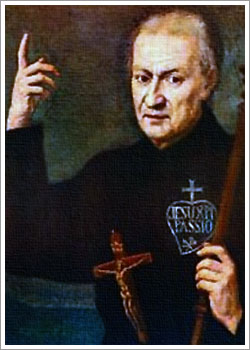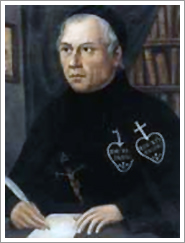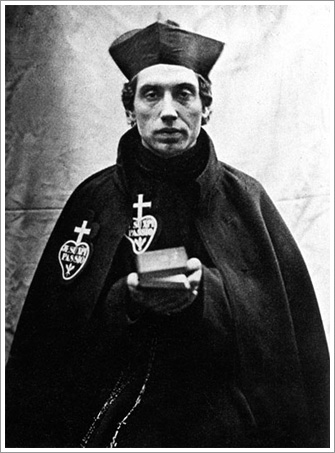Andrew Houben arrived at Ere on 5 November 1845. The Chateau d’Ere had belonged to Baroness de Croeser of Valenciennes, who had given the property to the Passionists as their first monastery outside Italy. With the arrival of four Passionists from Rome on 15 June 1840, the house was renamed Holy Cross Retreat; the word ‘Retreat’ was used by the founder of the Passionists, St Paul of the Cross, when referring to the houses of his Congregation, as exemplifying the spirit of prayer, penance and solitude which animates the Passionist life.
As a young man St Paul of the Cross had felt drawn to a life of contemplation, centred on the Passion of Jesus, but at the same time he believed that God was calling him to be a preacher of the Mystery of the Cross, sharing with others the message of God’s infinite love which is revealed on Calvary. In 1720, at the age of twenty-six, Paul wrote a rule of life for a new community whose members would contemplate and proclaim the Mystery of the Cross. The Paschal Mystery of Christ’s Death and Resurrection, source of life for all who believe, was symbolised for Paul in the distinctive dress of his community: a black habit on the front of which is the badge or sign of the Passionists -- surmounted by a white cross, the symbol of a heart in which are inscribed the words ‘the Passion of Jesus Christ’. In his writings he explains that when, as a young man, the form of the habit was revealed to him as he prayed, he heard these words of explanation: ‘This signifies how pure and spotless that heart should be which must bear the holy name of Jesus graven upon it.’
 St Paul of the Cross has a special love for ‘England and the neighbouring kingdoms’ of Ireland and Scotland. It was his hope that some day the Passionists would work there for the healing of the divisions between Christians, seeking unity under the Cross of Christ. His ecumenical vision and lifelong prayer bore fruit when Blessed Dominic Barberi, who had opened the house at Ere, set out for England with one companion in October 1841. When Andrew Houben arrived at Holy Cross Retreat four years later, everyone in the house would have been talking about England. Just three weeks earlier Blessed Dominic had arrived from Oxford with the news that he had received John Henry Newman into the Catholic Church, an event which proved to be not just the talk of the monastery but the talk of Europe. Naturally Andrew, on hearing this, would have been filled with enthusiasm for the English foundation and for the work of promoting Christian unity. above: St Paul of the Cross, founder of the Passionists
St Paul of the Cross has a special love for ‘England and the neighbouring kingdoms’ of Ireland and Scotland. It was his hope that some day the Passionists would work there for the healing of the divisions between Christians, seeking unity under the Cross of Christ. His ecumenical vision and lifelong prayer bore fruit when Blessed Dominic Barberi, who had opened the house at Ere, set out for England with one companion in October 1841. When Andrew Houben arrived at Holy Cross Retreat four years later, everyone in the house would have been talking about England. Just three weeks earlier Blessed Dominic had arrived from Oxford with the news that he had received John Henry Newman into the Catholic Church, an event which proved to be not just the talk of the monastery but the talk of Europe. Naturally Andrew, on hearing this, would have been filled with enthusiasm for the English foundation and for the work of promoting Christian unity. above: St Paul of the Cross, founder of the Passionists
Before he could be received as a novice, Andrew spent a month as a postulant. The period of postulancy is a time in which the candidate is introduced to the community so that he can learn about its life and so that the community can judge whether or not he is suitable for acceptance as a novice. Before a young man would be admitted into the novitiate St Paul of the Cross wished his patience and humility to be tested; in the sixth chapter of the Rule he wrote:
For this end he shall be publicly reprehended, particularly in the refectory, and shall sometimes eat upon the ground, and perform other humiliating and mortifying works ordered by the Superiors, from which it may be clearly known whether he has a real love of being despised; whether he be dead to himself and to the world, in order to live only to God, in God, and through God, willingly hiding his life in Jesus Christ, who, for our sakes, chose to become the reproach of men, and the outcast of the people, giving the most faultless example of all virtues.
At the end of his postulancy, on the recommendation of the Master of Novices, Fr Valentine Guerrini, the community decided to accept Andrew as a novice. On the evening of 1 December, after Compline, he was clothed in the black habit of the Passion and given the name Charles. As one who would later study for the priesthood, he would be addressed as Confrater rather than Brother; for his devotional title he was permitted to keep the name of the patron he had since baptism: Andrew. From now on he would be known not as Andrew Houben but as Confrater Charles of St Andrew.
The seven years Charles spent as a novice, student and student-priest represent the most hidden part of his life. These are years about which we know practically nothing. There have come down to us from this time none of his letters and only a few recollections of his companions. Yet these were the years in which the foundations of his future priestly and religious life were being laid; the grain of wheat lay buried in the ground, waiting to bear much fruit.
In the first months of his novitiate year, Charles was joined by other young men from Holland, including Isidore Brems who would later be Provincial of Belgium, France and Holland, and Michael Emons who was, like Charles, a former pupil of Mr Schrijen of Broeksittard. According to Michael, even as a young man Charles was ‘always humble, simple, charitable and exact in the observance of the Rule. He was greatly loved by his superiors and companions because of his simplicity, humility and obedience.’
Blessed Dominic, who visited the community while Charles was a novice, was very happy with the way things were at Ere. He wrote to the General, Fr Anthony Testa, on 29 September 1846, ‘There are eight novices. Almost all seem to be to be quite good, expecially the six Dutch, who have an angelic nature.’ Dominic went on to say that he was also pleased with the Novice Master; he found him quite lively, but, he added, ‘that’s not a crime!’
 Towards the end of that year, on 10 December, Charles made his religious profession. The profession should have been earlier but it was delayed for a week or so because the superior, Fr Peter Magagnotto, was in France giving a retreat to the Benedictines at Douai. At his profession, as well as the three vows of poverty, chastity and obedience, Charles took the distinctive vow of the Passionists, by which he committed himself to contemplating the mystery of Christ’s suffering and promoting in the hearts of others the memory of the Passion. After pronouncing his vows he received the Passionist sign which, as a professed member of the Congregation, he would now wear on his habit. above: the sign of the Passionists
Towards the end of that year, on 10 December, Charles made his religious profession. The profession should have been earlier but it was delayed for a week or so because the superior, Fr Peter Magagnotto, was in France giving a retreat to the Benedictines at Douai. At his profession, as well as the three vows of poverty, chastity and obedience, Charles took the distinctive vow of the Passionists, by which he committed himself to contemplating the mystery of Christ’s suffering and promoting in the hearts of others the memory of the Passion. After pronouncing his vows he received the Passionist sign which, as a professed member of the Congregation, he would now wear on his habit. above: the sign of the Passionists
Charles’ remaining years at Ere were spent studying philosophy and theology. His teacher was Fr Seraphin Giammaria, but the course which was followed was the work of Blessed Dominic, whose textbooks Fr Seraphin used. We hear no further mention of Charles having difficulties with his studies. He would never be a great theologian like Blessed Dominic, but he was able to deal with the material put before him as a student; besides, he had other gifts in abundance, more important in a religious than intellectual ability, as one of his classmates recalled:
He was an example of devotion, full of faith and piety, strict in keeping our rules, simple and friendly to live with. His tender and honest nature, his artless all-embracing piety, his good humour and natural cheerfulness during recreation made everyone love and respect him.
Another description of Charles as a student was given by Brother Anthony Raaymakers:
He was an excellent religious, with the gentleness of an angel. You could have knocked him over and instead of a complaint, you would have got only a lovely, gentle smile. He was always content with a little and took everything in good part. If he happened to neglect any of his duties, he would always apologise of acknowledge his fault in public.
 Although not yet ordained, Charles was shaping up to be just the kind of person Blessed Dominic right wanted for the English foundation. Writing to the Superior General to ask him to send another priest to England, Dominic had said,
Although not yet ordained, Charles was shaping up to be just the kind of person Blessed Dominic right wanted for the English foundation. Writing to the Superior General to ask him to send another priest to England, Dominic had said,
It does not matter whether he has great talent or not. What does matter is that he should have plenty of good will, and be prepared to suffer many things -- derision, mockery, contempt. That would, to a great extend, be his lot here. Those who come must not look for comforts, but a full meal of insult and outrage of every kind.
Dominic was speaking here from bitter experience. He had lived in England only twelve years after Catholic Emancipation and there was still a great deal of suspicion and even hatred of Catholicism to be encountered. Every Sunday morning as he walked the two miles from the monastery to the town of Stone to celebrate Mass, Dominic would be insulted and attacked, as an eye-witness recalled:
Behind him surged a rabble of all the local wastrels, from whose mouths came words of ribald and unrepeatable insult. As he passed under the windows the more respectable citizens joined in the hideous outcry against the Demon, the Papist, the Devil! Slowly then in the midst of his horrible escort walked Father Dominic, aflame with love for souls. Stones and mud rained upon him. Once, at a later time, he was asked how he had got the terrible scar on his forehead. It was, as he at last confessed, caused by a violent blow from a stone used as a weapon.
This was the missionary life for which the young religious were being prepared. From Blessed Dominic, Charles and his fellow-students would have heard of the work that was to be done in England, a work of reconciliation. They would also have heard something of the sufferings they might expect to find there, sufferings which, as Dominic admitted in a letter to a friend, he found extremely painful:
I spent so many years before coming to this Island preparing myself, at all times, for suffering. And now, it seems to me that, if I had ever foreseen all that awaited me, I should never have had the courage to step on board ship. Such sufferings, and of every kind, too, would be too much for a giant. Last Sunday I broke down and wept bitterly. I can do no more. The cross is too heavy. My God! if you intend to increase it, you must increase my strength, too.
Blessed Dominic visited Ere for the last time in July 1849. At the end of his visit, when he was leaving to return to England, the students, among whom was Charles, were reluctant to let him go, as one of them recalled:
The students, of whom I was one, obtained permission to go with him to Tournai. When we were about a quarter of an hour’s walk from the town Fr Dominic stopped and said: ‘My sons, you may go back now. Embrace me -- it is the last time in this world. But I hope one day to embrace you again in heaven.’ We remarked that he was young still, and in good health, and that there was no reason to speak like that. ‘I tell you,’ he replied, ‘it is the last time -- good-bye.’
A month later he lay dying on the platform of Pangbourne railway station.
 On Saturday, 21 December 1850, Charles was ordained to the priesthood by Monsignor Gaspare Labis, Bishop of Tournai. The ceremony took place in the Bishop’s Chapel, beside the Cathedral. Charles had been ordained on 25 May and now at the end of the year he became a priest. 1850 was a very happy year for him, but it was also a year of great sorrow; four months before his ordination, on 7 August, his father had died. It must have saddened Charles, as he celebrated Mass for the first time, to think that his father had not lived to see him ordained and to receive his first blessing. In fact, none of his family was present at the ordination; his only link with home was the companion of his schooldays, Michael Emons, who was ordained with Charles. above: a photograph taken close to the time of Father Charles’ ordination
On Saturday, 21 December 1850, Charles was ordained to the priesthood by Monsignor Gaspare Labis, Bishop of Tournai. The ceremony took place in the Bishop’s Chapel, beside the Cathedral. Charles had been ordained on 25 May and now at the end of the year he became a priest. 1850 was a very happy year for him, but it was also a year of great sorrow; four months before his ordination, on 7 August, his father had died. It must have saddened Charles, as he celebrated Mass for the first time, to think that his father had not lived to see him ordained and to receive his first blessing. In fact, none of his family was present at the ordination; his only link with home was the companion of his schooldays, Michael Emons, who was ordained with Charles. above: a photograph taken close to the time of Father Charles’ ordination
Peter Joseph Houben, Charles’ younger brother, had in the meantime entered the diocesan seminary and was studying for the priesthood. In a letter written to Charles on 21 September 1851, Peter talks about how he had intended to visit Ere, but was advised to change his plans:
I really intended visiting you during the vacation, but unfortunately I had to renounce my purpose with regret. As my brothers and sisters wished also to go to Ere they advised me to put off this agreeable journey to a more favourable time.... Time destroys monuments, but your memory will never be erased from our hearts.... Fr Ignatius Spencer has been preaching a holy crusade in the seminaries, asking prayers for England’s conversion. He left our College for Germany and was received with marks of distinction in Cologne by his Eminence the Cardinal, who offered him a house as a foundation of the Congregation of the Passion.
Unfortunately, the favourable time for Charles’ brothers and sisters to visit him did not come; on 16 February 1852 he left Holy Cross Retreat, Ere. The Provincial, Fr Eugene Martorelli, had called him to England.
top of page

© Paul Francis Spencer, C.P. 2007 - 2020 - all rights reserved
This biography, paper-published in 1988 at the time of Father Charles’ beatification, was how I became acquainted with the life of Father Charles. Although you will find the entire text at this site, I encourage you to look for the new paper edition of the book, which will be available in bookshops in mid-2007.

